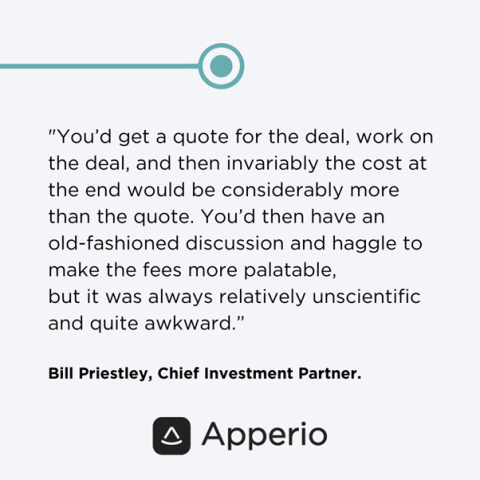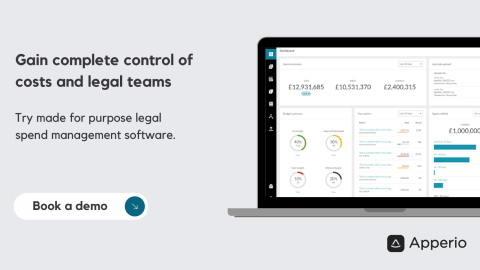5 classic corporate legal cost control strategies and their limitations

What frustrates legal and finance teams about outside counsel spend isn’t just price, it’s opacity: studies show clients are willing to pay for good counsel, but they want predictability and transparency
The stakes for corporate counsel have never been higher. A recent CLO survey found that while businesses have a greater appreciation for in-house counsel, most are managing a higher volume and variety of work – and facing stronger cost pressures at the same time.
In response, many are redoubling their efforts to control costs. Yet some of the classic corporate legal cost strategies come with limitations. Understanding these drawbacks is key to setting realistic expectations and implementing more effective cost-management practices.
With that in mind, in this blog, we’re lasering in on five classic legal cost control strategies. Plus, we’ll cover alternative and more advanced methods to manage legal budgets better.
Let’s jump straight in.
5 legal cost control strategies
You may already be using some of these practices and so will recognise the limitations:
1. Negotiating law firm discounts ➗
On a strategic level, discounts can work when a law firm trades a lower rate for a greater share of your business. However, the discounts have been gamified: law firms raise rates annually, so despite the discount, the real costs continue to grow.
On a tactical level, discounts can also reduce a surprisingly high invoice. To keep a good client happy, a law firm may write-down (reduce) or write-off (eliminate) certain fees. This can be a good fix for a one-time occurrence, but if it happens a lot, it creates friction between the client and the service provider.
Most important of all, a discount doesn’t solve the underlying problem, which is to understand why a matter is going over budget.
2. Leveraging alternative fee arrangements 🔀
Alternative fee arrangements (AFAs), especially fixed fees, are often heralded by pundits and in the press as the answer to predictable pricing. Yet the idea tends to work better for low-value or “commodity” type work than it does for high-value work like litigation or due diligence for several reasons.
First, it’s very hard to name a flat price for a high-value project where opposing counsel – a variable – can influence the price. The harder the other side fights the higher your own legal costs.
Second, fixed fees can put law firms at odds with clients. If a legal project takes less time than the proposed fixed fee, the law firm “wins” with higher profit and the client “loses” because they may have overpaid. If the project takes more time than proposed, the client “wins” and the law firm “loses” because they eat the difference.
Third, the latter can incentivize law firms to take shortcuts to make up for losses. An example is pushing work down to less experienced lawyers.
Fourth, many in-house lawyers started their careers working for law firms, so the billable hour is familiar. They understand how it works, where AFAs can feel risky and difficult. The inside joke is when a law firm hears a client talk about AFAs, what they are really asking for is a discount.
Fifth, many fixed fees wind up being renegotiated. An independent survey we commissioned of in-house lawyers working for PE and VC firms found 74% said fixed fees were renegotiated some of the time. Of those, four in 10 said this happens always or often.
There are other variations of “alternative” fees including capped fees, contingencies, holdback agreements and more. Network Rail had success using holdback arrangements in conjunction with Apperio to incentivize accurate pricing estimates from their firms.
It’s worth noting, Apperio maintains that while AFAs have value in certain matter categories, the billable hour is the truest representation of legal costs for high-value legal work. The problem, as we see it, is the opacity around time and billing rather than the method of calculation.
3. Requiring status updates from law firms 🆕
Corporate counsel can ask their law firms for status update meetings or reports. This is effectively a communications process to review the state of a matter in comparison to a budget.
Some clients make this part of the routine. They might host a status meeting every two weeks for example. Others make it an ad hoc request as needed.
This is a strain on law firms. Timekeepers in law firms are notorious for procrastinating about time entry. So, when a client asks for an update, it creates a scramble. Even after the time is entered, the law firm still needs finance to pull the data, analyze it and create a report they can deliver to the client.
The benefit for corporate counsel is fleeting as well. This is because the process takes so long to unfold, that the data goes stale quickly. Even worse, it shifts the conversation between client and outside counsel to costs – and distracts everyone from the legal work at hand.
4. Legal operations ⚙
Legal operations is a maturing function many legal departments have implemented. Its mandate is to improve efficiency and lower legal costs. Achieving this may include identifying, procuring and implementing technology and process innovation.
Legal ops professionals have the time and resources to examine costs, processes, pricing and spending. They tend to be equal parts project managers, workflow experts and financial analysts. Legal ops may be led by a lawyer or “allied professionals” (non-lawyers, MBAs, etc.).
Law firms have come to view client-side legal ops as a way for clients to squeeze them for lower pricing. Over the last 10 years or so, law firms responded in kind by hiring operations staff of their own, along with project management and pricing professionals – which drives up costs and subsequently prices.
Even with dedicated legal ops help, getting a handle on legal spending remains a heavy lift on the client side. For example, legal ops still have to contact their law firm once a month to ask for a status update. Then they receive the data in various formats (emails, phone calls, spreadsheets, presentations) and finally, copy and collate the data into a consolidated report.
This is a highly manual process that’s prone to human error. Here again, timing is a factor because the data becomes outdated even as it’s being collected. It’s very challenging to get a real-time view of your current legal spend and make accurate forecasts this way.
To be sure, legal operations teams have grown in size and industry stature because they are effective. However, they need to be properly resourced just like any other team in the business.
5. Electronic billing (e-billing) solutions 📨
In recent history, corporate legal departments only have one primary technology available to help them solve this problem: e-billing. E-billing helps legal departments standardize invoice data and bring structure to the invoice review process.
E-billing tools do provide sound analytics on year-end data. Many even aggregate invoice data across corporate clients and provide anonymized spending benchmarks in return. This allows in-house counsel to benchmark law firm rates across vertical markets, practice areas and geographies.
E-billing tools have a major shortcoming for corporate counsel. These require an invoice to initiate analysis and do not provide visibility into current spend or accruals. If a law firm is sitting on unbilled time or work-in-progress (WIP) the legal departments are still in the dark about where they are spending currently.
E-billing often delivers low single-digit write-downs for the client, but at the expense of a relationship with a valued provider of legal counsel.
Why legal cost control is so hard
All of the strategies above have value, but none of them remove the muddiness around timekeeping, billing and invoicing in the business of law. For example, knocking 10% off a billing rate doesn’t provide the client with insight into the composition of an invoice. So, the culprit here – and the reason legal costs are hard to control – is opacity.
Study after study shows clients are willing to pay for good counsel. However, they also want predictable costs – and predictable costs require transparency.
And that’s where advanced strategies can help.
Advanced legal cost control strategies
Leading organizations follow several best practices to gain legal cost control and confidence in managing legal spend.
Here are a few examples:
1. Leverage smart software
With so much at stake, relying on guesswork isn’t an option. Comprehensive legal spend management software offers complete visibility into every aspect of legal spending, providing data-driven insights that you can trust.
💡 Top tip: Opt for systems that seamlessly integrate with your existing financial systems and offer real-time analytics.
2. Centralize spend intelligence
Create a single source of truth by consolidating legal spend data from various departments, outside counsel, and regions. Solutions that feature visual dashboards enable you to quickly see how legal spend is being managed. This approach facilitates better collaboration and simplifies analysis and cost optimization.
💡 Top tip: Choose tools that can assess performance against your historical data and industry benchmarks.
3. Implement data-driven decision-making
Utilize analytics to identify spending patterns, uncover savings opportunities, and gain crucial insights before negotiating with law firms. This enables your legal and finance teams to make smarter, more informed decisions.
💡 Top tip: Invest in analytics platforms with predictive modeling capabilities. These tools can forecast future spending scenarios based on current data and trends, allowing for proactive budgeting and spend management.
With capabilities like this, you can expect to:
✅️ Understand the value your law firms provide
✅️ Examine beyond the invoice total, considering rates and staffing quality
✅️ Enhance relationships with both internal and external stakeholders
✅️ Automatically track spending against budgets
✅️ Minimize manual effort in data collation and report creation
✅️ Enable faster decision-making and reduce friction in the billing process
This all sounds quite theoretical so let’s look at a real-world application.
Case study: Private equity legal cost control simplified
Epiris invests in UK businesses with an enterprise value of between £75m - £500m. Frustrated in the past by a lack of clarity and understanding over what the firm would be paying for in legal fees, Epiris’s Chief Investment Partner sought a solution.

With legal fees ranging from between £500,000 to £1m per transaction, Epiris needed a better way to manage costs much more proactively.
Epiris began using Apperio in 2018 and has found this to be a crucial tool in helping internal investment and finance teams to understand legal spend in greater detail and manage the external matters currently in progress.
📘Read the full case study here.
Mastering legal cost control for optimal budget management
It's clear that the traditional strategies, while valuable, are not sufficient to fully address the opacity that blurs the view of legal expenses. The problem isn't just the cost—it's the lack of clarity about where the money goes. Advanced strategies, such as leveraging smart software and centralizing spend intelligence, provide a more transparent, data-driven approach to meet the modern demands of legal spend management.
By adopting these advanced methods, organizations can not only gain a clearer picture of their legal spending but also enhance the efficiency and effectiveness of their legal operations. The key takeaway here is that transparency isn't just a nice-to-have—it's essential for predictability in legal costs.
Keen to learn more? Read these blogs for more legal cost control best practices:
- Boosting cost control: the way you use Alternative Fee Arrangements matters
- How to save legal costs across the portfolio
- How legal teams can use benchmarking to improve decision-making
Ready to get started today? Book a demo to see how Apperio's legal spend management software providers in-house legal teams with the transparency to manage their legal spend.
